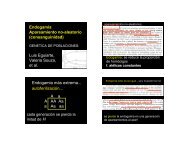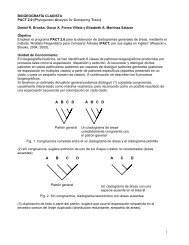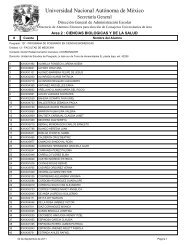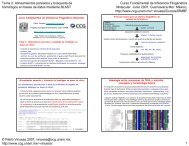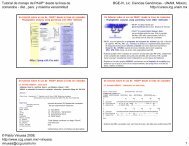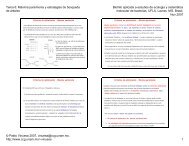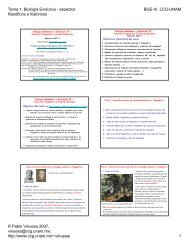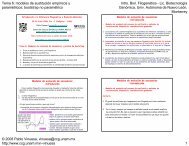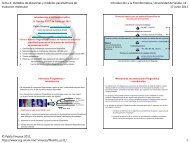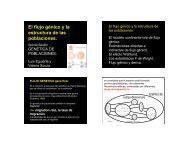Chromosome Structure
Chromosome Structure
Chromosome Structure
You also want an ePaper? Increase the reach of your titles
YUMPU automatically turns print PDFs into web optimized ePapers that Google loves.
<strong>Chromosome</strong> <strong>Structure</strong>N Patrick Higgins, University of Alabama, Birmingham, Alabama, USAGenes are organized into discrete cellular structures called chromosomes that coordinateDNA replication and distribution of replicated genetic copies between two daughter cells.As vehicles of genetic transmission, chromosomes play a central role in Darwinianevolution.AbundanceBiology is divided into three great kingdoms: Eubacteria,Archaea and Eukaryota. Bacteria (Eubacteria and Archaea)are ubiquitous in the environment, and these smallsingle-celled organisms grow over an amazingly wide rangeofenvironmental conditions. For example, bacteria cangrow at temperatures below freezing, and certain membersofthe archaea can grow at depths ofover three miles and attemperatures exceeding 6008F and 200 atmospheres ofpressure. Eukaryotes, which include the more conspicuousfungi and all plants and animals, are usually recognized asthe predominant life forms on earth. They are subjects ofgreat biological interest and they differ from bacteria byhaving a larger cell size and by compartmentalizingchromosomal deoxyribonucleic acid (DNA) in a nucleus,which separates it from the protein-making cytoplasm.None the less, considering the large cell numbers and wideenvironmental growth ranges, bacteria easily account forthe majority ofDNA biomass on earth.The chromosome is the heart ofa central paradox inevolution. How do species in the three kingdoms remainthe same over long periods ofgeological time and alsogenerate sufficient variability to produce new species,sometimes relatively rapidly? Stability versus change is acrucial dichotomy in molecular biology. The events thatbring about stability and change in DNA structure involveprocesses ofreplication, transcription and recombination.Similar mechanisms operate in the three living kingdoms,but the key molecular mechanisms that control andcatalyse these events are understood best in a eubacterium:Escherichia coli.<strong>Chromosome</strong> SizeFree-living bacteria need genetic information to synthesizeproteins for executing vital functions. Most bacteria have asingle chromosome with DNA that is about 2 Mbp (megabase pairs) long (1 Mbp 5 1 000 000 base pairs), but theDNA content ofdifferent species varies from 0.58 togreater than 9 Mbp ofDNA, and some bacteria havemultiple chromosomes. For example, Leptospira has twochromosomes of4.4 and 4.6 Mbp and the largest bacterial. AbundanceIntroductory article. <strong>Chromosome</strong> Size. Plasmids. <strong>Chromosome</strong> ShapeArticle Contents. Enzymes of DNA Topology. Chromatin. DNA Replication. Eukaryotic Segregation. Transcription. Recombination. Chi Sites. Transposons. Site-specific Recombinationgenome yet analysed is that of Myxococcus xanthus, with9.2 Mbp (9 200 000 bp). However, the best studied organismin nature is E. coli, which has a 4.6-Mbp chromosomewith 4288 genes for proteins, seven operons for ribosomalribonucleic acids (RNAs), and 86 genes for transfer RNAs.The E. coli chromosome contains numerous genefamilies, each family having evolved from a commonancestor. The largest gene family is comprised of 96 threecomponent(ABC) transporters, which are membraneboundmachines that import and export a variety ofsmallmolecules and proteins. By contrast, the smallest freelivingorganism is Mycoplasma genatalium with a 0.58-Mbp genome that encodes 468 protein genes, oneribosomal RNA operon and one ABC transporter. BothE. coli and M. genatalium have complete information forthe synthesis ofcell walls, cell membranes and criticalenzymes ofintermediary metabolism, plus the RNAmolecules, ribosomal proteins and a clutch ofenzymes(the replisome) to replicate DNA efficiently. Putativefunctions for about a quarter of the genes of E. coli remainto be discovered. A reasonable estimate is that 150–200protein-encoding genes would be ‘essential’ for a basicbacterial lifestyle (in a rich medium).Eukaryotic organisms generally have larger chromosomesthan bacteria. For example, the yeast Saccharomycescerevisiae has about 6000 genes (50% more than E.coli), whereas mammalian cells contain 1000 times (perhaploid equivalent) the DNA ofan E. coli cell. In humansthe 5000 Mbp ofhaploid DNA is distributed among 22autosomes and two sex-specific chromosomes. EukaryoticDNA is localized in a compartment, the nucleus, which isseparated by a phospholipid-containing membrane fromcytoplasmic ribosomes and protein translation activity.During cell division, the eukaryotic nuclear membraneENCYCLOPEDIA OF LIFE SCIENCES / & 2001 Macmillan Publishers Ltd, Nature Publishing Group / www.els.net1
<strong>Chromosome</strong> <strong>Structure</strong>breaks down once per cell cycle to distribute the 46 diploidchromosomes equally between two daughter cells.PlectonemicParanemicPlasmidsIn addition to the large chromosome, many (most?)bacteria have additional DNA molecules called plasmids(or episomes.) Plasmids are separate DNA molecules thatcontain a replication origin which allows them to multiplyindependently ofthe host chromosome. Plasmids range insize from 1 kbp (Kilo base pair) (1000 bp) to 100 kbp, andthese DNA molecules encode genetic systems for specializedfunctions. Some plasmids make extracellular appendagesthat allow bacteria to infect and colonize sensitiveeukaryotic hosts. Plasmids often carry genes that confer onbacteria the ability to survive in the presence ofantibioticssuch as tetracycline, kanamycin and penicillin. Manyplasmids also contain genes that promote DNA transfer sothat plasmid genes can move into other bacterial species.Plasmid transfer has caused the emergence of bacterialpathogens that are resistant to most ofthe usefulantibiotics in medicine, with notable examples includingmultidrug-resistant strains of Staphylococcus and Mycobacteriumtuberculosis.In most eukaryotes, plasmids are rare. However, S.cerevisiae contains a plasmid called the 2-m circle whichefficiently partitions to new daughter cells at every celldivision. This DNA serves as a convenient module for genecloning and performing genetic experiments in yeast.<strong>Chromosome</strong> ShapeOn a macroscopic scale, bacterial chromosomes are eithercircular or linear. Circular chromosomes are mostcommon, at least among the best-studied bacteria. However,the causative agent ofLyme disease, Borreliaburgdorphei, has a 2-Mb linear chromosome plus 12different linear plasmids. Eukaryotic chromosomes areinvariably linear, and they have two ends, each carrying aspecial structure called a telomere, and a organized regioncalled the centromere which allows the chromosome toattach to cellular machinery that moves it to the properplace during cell division.One critical facet of chromosome structure is that DNAis a plectonemic helix, which means that two helical strandsentwine about each other. For duplex DNA the twoantiparallel strands, often referred to as the Watson andCrick (red and blue in Figure 1), are interwound once forevery 10 bp. Because ofthis wound configuration, biochemicaltransactions that involve strand separationrequire chromosome movement (spin) about DNA’s longaxis. The processes ofDNA replication, recombinationand transcription all require DNA rotation, and duringEukaryotic chromatinSolenoidalsupercoilsσ = –0.05(a)(b)HistoneassemblyDeproteinate5kbpPlasmidGyraseInterwoundsupercoilsσ = –0.05TopoIVTopoIIProkaryotic chromatinHUH-NSFigure 1 (a) DNA is a plectonemic helix (left) rather than a paranemichelix (right), and thus it must spin axially to undergo replication,transcription and extended pairing for homologous recombination.Supercoiling in circular bacterial chromosomes is maintained by theconcerted action of DNA gyrase, which introduces negative supercoils atthe expense of adenosine triphosphate (ATP) binding and hydrolysis, andTopoI plus TopoII, which remove excess negative supercoils. Negativesupercoiled DNA adopts an interwound conformation. However,‘solenoidal’ supercoils can be stabilized when DNA is wrapped on a proteinsurface. This is the mechanism of supercoil formation in mammalian cells(centre left). Most bacteria have nonspecific DNA-binding proteins such asHU and H-NS, which stabilize supercoils but are much less effective atcondensing DNA compared with true histones (centre right). (b) Bacteriaand eukaryotes both have an enzyme, TopoIV and TopoII respectively,designed to unknot and untangle DNA.DNA synthesis the rotation speed approaches 6000 rpm.Chromosomal DNA molecules are very long and thin, soDNA must fold many times to fit within the confines of abacterial cell. How does DNA twisting transpire withoutchromosomes getting tangled up? The problem wasimportant enough that Watson and Crick considered aparanemic helix, which is a pair ofcoils that lay side by sidewithout interwinding. Strands ofa paranemic helix canseparate without rotation (Figure 1). None the less DNA isplectonemic, and keeping chromosomes untangled requiresa special class ofenzymes called topoisomerases.2 ENCYCLOPEDIA OF LIFE SCIENCES / & 2001 Macmillan Publishers Ltd, Nature Publishing Group / www.els.net
<strong>Chromosome</strong> <strong>Structure</strong>Enzymes of DNA TopologyThe enzymes that solve the untangling problem aretopoisomerases. Topoisomerases break and rejoin DNAmolecules, thereby allowing individual strands to pass onethrough another. The number ofphosphodiester bondsbroken and reformed per reaction cycle divides topoisomerasesinto two classes. Type I enzymes, which includeTopoI and TopoIII (the odd-numbered topoisomerases),break one strand per cycle, and type II enzymes (evennumbered), gyrase, eukaryotic TopoII, and E. coliTopoIV, break two strands simultaneously. These enzymeshave two important roles: they provide a swivel toallow processes such as replication and transcription toproceed unimpeded, and they untangle knots and interchromosomelinks between DNA molecules.In all organisms DNA becomes organized into supercoils,which are turns ofthe double strand over theinterwound twists ofthe Watson–Crick helix. Supercoilscan be either positive or negative; negative supercoils areopposite to the handedness ofthe Watson–Crick turns,and positive supercoils have the same handedness. Supercoildensity is defined by a term s, which represents thenumber ofsuperhelical turns divided by the Watson–Crickturns ofa double helix. Supercoiling influences theWatson–Crick structure and, like the spring, the freeenergy ofsupernegative supercoils increases exponentiallywith quantity. Enzymes that unwind DNA to carry outtheir function (RNA polymerase and DNA replisomes)may sense and utilize supercoiling energy. However, oncenegative supercoiling has reached a critical density, theWatson–Crick structure will unwind locally, forcing DNAinto alternative structures to relieve tension. Well-studiedsupercoil-dependent alternatives to the Watson–Crickform of DNA include left-handed Z-DNA, cruciforms,and triple-stranded or H-form DNA.In eubacteria, gyrase, TopoI and TopoIV maintain invivo supercoiling levels, s 520.05 to 2 0.075. Gyrase isunique for its ability to introduce negative supercoils intorelaxed, positively or negatively supercoiled DNA at theexpense ofadenosine triphosphate (ATP) binding andhydrolysis. An essential enzyme in bacteria, gyrase iscritical for DNA reactions that include recombination,replication, transcription and chromosome segregation. Invitro, DNA gyrase can supercoil DNA to a value ofs 520.1, a level at which many sequences adopt analternative structure. In vivo, s is buffered by the counteractiverelaxing activity ofTopoI and TopoIV. The secondcritical function of topoisomerases is untangling andunknotting DNA (Figure 1b). Eukaryotic TopoII and E.coli TopoIV efficiently unknot and untangle chromosomes,and after replication this activity allows thechromosomes to segregate into daughter cells.Although an average eukaryotic nucleus is larger thanan E. coli cell, nuclear DNA is even more concentratedthan bacterial DNA. Rather than being supercoiled by anenzyme such as gyrase, eukaryotic DNA is wrapped tightlyaround nucleosomes, generating solenoidal supercoils thatcondense DNA 8-fold (Figure 1). A nucleosome containsfour subunits: histones H2A, H2B, H3 and H4. If histonesare stripped from DNA by protein denaturants, eukaryoticDNA adopts the interwound structure ofbacterialchromosomes, with about the same negative superhelixdensity (Figure 1).Eukaryotes have three topoisomerases: TopoI andTopoIII are type 1 enzymes that break only one strand,and TopoII is the only type 2 activity that breaks bothstrands simultaneously. Eukaryotic TopoI removes bothpositive and negative supercoils from DNA, whereasTopoII carries out unknotting and decatenating reactions(see below). TopoI and TopoII are essential for eukaryoticcell viability; the functions of TopoIII in both eukaryotesand bacteria remain undefined.ChromatinChromatin is a term that refers not just to DNA but to theproteins attached to a chromosome. In the dimensions ofB-form DNA, E. coli is a sphere that is 6 kbp long (8 nm)and 4 kbp wide (2 nm), so the 4.6-Mbp chromosome mustbe folded many times to fit within a cell. Negativesupercoiling forces DNA into an interwound configuration(Figure 1). Interwound supercoiling is produced at theexpense ofATP by the enzyme gyrase, and supercoilingproduces two important consequences. First, the DNAmolecule doubles back on itselfso that length is halvedrelative to that ofthe linear form. Second, supercoiledbranches are dynamic so that opposing DNA sites in theinterwound network are constantly changing. A proteinbound to DNA in one supercoiling domain interacts morethan 100 times more frequently with other proteins in thesame domain than it does with proteins bound to adifferent domain. When DNA is liberated from cells bybreaking the peptidoglycan coat, chromosomes formbundled loops that represent domains. Such preparations(called nucleoids) behave as discrete bodies.Many reactions ofthe chromosome require the formationofintricate DNA–protein machines to replicate,transcribe or recombine DNA at specific sequences. Agroup of‘chromosome-associated’ proteins assists in theformation of these complexes by shaping DNA. Theseproteins are sometimes described as histone-like, althoughthey share no structural similarity with the eukaryotichistones (Figure 1). <strong>Chromosome</strong>-associated proteinsinclude HU, H-NS, intregation host factor (IHF) andfactor for inversion stimulation (FIS).HU is encoded by two genes, hupA and hupB, which areclosely related to each other and to the genes encoding thetwo IHF subunits. HU is the most abundant doublestrandedDNA-binding protein in E. coli, although it alsoENCYCLOPEDIA OF LIFE SCIENCES / & 2001 Macmillan Publishers Ltd, Nature Publishing Group / www.els.net3
<strong>Chromosome</strong> <strong>Structure</strong>binds RNA. Although HU shows a preference forstructurally ‘bendable’ sequences, it binds DNA relativelynonspecifically, forming complexes that stabilize negativesupercoils in double-stranded DNA (Figure 1). In phage Mutransposition reactions, HU binds to a flexed DNAstructure called a transpososome with high affinity andspecificity.H-NS is a second relatively nonspecific DNA-bindingprotein that forms dimers, tetramers and possibly higherorderassociations when bound to DNA. Like HU, H-NSconstrains negative supercoils. H-NS binds ‘bendable’DNA, which include AT-rich sequences often found nearbacterial promoters; H-NS also modulates the transcriptionofnumerous operons in E. coli and oflysogenicphages.FIS protein forms homodimers and binds DNA atspecific sites. FIS was discovered nearly simultaneously intwo related site-specific recombination systems: the Hininversion reaction of Salmonella typhimurium and the Gininversion reaction ofphage Mu. FIS concentration rises inearly log phase when the protein has regulatory roles inreplication initiation at oriC and transcription ofribosomalRNA operons, and then FIS abundance declines instationary phase.IHF protein is composed oftwo subunits (encoded bythe himA and hip genes) that are about 100 amino acidslong and which make stable heterodimers. IHF proteinbinds to a consensus sequence that was first discovered inphage l, where it stimulates insertional and excisionalrecombination in vitro by a factor of 10 4 . IHF bends DNAseverely (more than 908); such bends are critical for sitespecificrecombination in l, for repression and activationofphage Mu, and for repression–activation in a number ofcellular operons, including ilv, oxyR and nifA.In the eukaryotic nucleus, enzymes such as RNApolymerase gain access to DNA, which remains histonebound throughout most biochemical transactions. Theway in which multiple proteins interact with nucleosomecoatedDNA is not completely understood; however,protein access to DNA is modulated by histone structure.Histone phosphorylation and acetylation change chromatinstructure. Genes that are transcribed contain nucleosomeswith acetylated subunits ofhistones H3 and H4,whereas inactive genes are bound by histones lackingactetyl groups. In addition to the histones, eukaryoticchromosomes contain regulatory proteins that are muchless abundant. One class ofproteins, the high mobilitygroup (HMG) family of DNA-binding proteins, bendsDNA much like bacterial proteins IHF and FIS.DNA ReplicationThe central problem in chromosome replication isgenerating two high-fidelity DNA copies and distributingthem precisely to compartments that become the daughtercells. To control chromosomal replication temporally, andto integrate DNA metabolism with other aspects ofthe cellgrowth such as membrane synthesis and cell wall expansion,E. coli makes a master regulator, the DnaA protein,which controls the onset ofreplication at a site called oriC.The bacterial replication cycle can be described byprogression through four stages. Less detail is available foreukaryotes, but many points are similar. As cells grow, themass ofprotein and membrane increases to a critical pointthat triggers the initiation ofreplication. Two replisomesare associated in a ‘factory’ that moves to the cell centreduring chromosomal elongation. As DNA strands arepulled to the centre, replicated sister chromosomes migratetoward opposite cell poles. Completion ofDNA synthesisoccurs as the DNA that is pulled into the factory reachesthe terminus. At this point, chromosomes are tangledtogether (catenated), and all physical connections must beremoved to allow final separation. When physical separationis complete, cell wall synthesis forms two daughtercells.InitiationDNA replication starts at oriC near position 2 85 ofthestandard E. coli genetic map (Figure 2). Initiation involvesthe DnaA protein-assisted assembly oftwo replisomes,each dedicated to replicate halfa chromosome. Replisomecomponents include: the DnaB helicase, which is an ATPdependentring that moves along a single strand breakingopen the double helix for polymerase access; a dimericDNA polymerase molecule with accessory cofactors; and acomplex called the primosome that triggers RNA-primedinitiation ofnew DNA strands on one side ofthe growingfork. Each replisome has a pair of polymerase subunits:one synthesizes DNA continuously along the strand with5’–3’ polarity, and the other subunit synthesizes DNAdiscontinuously in small fragments called Okazaki pieces.Thus DNA replication is semidiscontinuous.In eukaryotic replication, initiation steps are not as fullyunderstood as they are in E. coli. Initiation occurs at arssites, so called because they are autonomously replicatingsequences (Figure 3). Initiation is controlled by a group ofproteins called ORC (origin replication complex). Typically,a chromosome has many ORC-binding sites, andbidirectional semidiscontinuous forks move out fromseveral ars sites on each chromosome until they convergewith other forks. Eukaryotic replication also occurs in‘factories’, and most of the chromosome is replicated in asemiconservative and semidiscontinuous mode, as in E.coli. The eukaryotic replication fork behaves very similarlyto that found in E. coli.4 ENCYCLOPEDIA OF LIFE SCIENCES / & 2001 Macmillan Publishers Ltd, Nature Publishing Group / www.els.net
<strong>Chromosome</strong> <strong>Structure</strong>Continuous strandSemiconservative andsemidiscontinuous replication(a)Discontinuous strandReplisomeEscherichia coli replicationReplichore IReplichore IoriCoriCE. coliWatson strand templateterEE. coliCrick strand templateReplichore IIterFterDterAterCterBdifReplichore II(b)Figure 2 (a) A replication fork is shown with a replisome as a blue box, moving and synthesizing DNA from left to right. Replication is semiconservative,meaning that a new strand is synthesized on each of the two parental template strands, and semidiscontinuous, meaning that the strand that followsthe fork with 5’ to 3’ polarity is made as one continuous piece while the strand that follows with overall 3’ to 5’ polarity is made discontinuously as Okazakipieces. (b) The two circular chromosomes show the products of bidirectional replication. Initiation starts at oriC ( 2 85) and proceeds clockwise in thezone called replichore I and counterclockwise through the zone called replichore II. Replication forks meet at a terminus near the dif site ( 2 34). Strandsmade in the continuous mode are shown in red, and discontinuous strands in blue. Also included in the map are the seven ribosomal RNA operons(arrowheads), five of which reside in replichore I and two of which are found in replichore II, six ter sites and the dif site. Note that the two daughters aresynthesized with different semidiscontinuous styles in replichores II and I so that the Watson and Crick strands are isomers.ElongationAfter initiation, duplication of the entire 4.6-Mbp E. colichromosome takes 40 min. One replisome copies DNA inthe clockwise direction (replichore I), while the otherreplisome copies DNA counterclockwise (replichore II)(Figure 2). DNA polymerase synthesizes new strands at astaggering rate of300 nucleotides per second. Replicationis semiconservative, meaning that one newly synthesizedstrand is made to match each parental template. BecauseDNA polymerases synthesize DNA only in the 5’ to 3’direction, and because replication forks copy bothtemplates at nearly the same time, there is asymmetry inthe mechanism ofchain growth. One strand is made as asingle piece while the other strand is synthesized in a seriesof1-kb segments, with each segment being initiated with asmall RNA molecule. These are called Okazaki pieces, andthey are stitched together after removal of the RNAprimers. This semidiscontinuous pattern ofDNA replicationis a recurring theme in organisms as diverse as plantsand humans.Because replication is semidiscontinuous, the sisterchromosomes (shown at the bottom of Figure 2) arereplication isomers. The template strand with 5’ to 3’polarity in the clockwise direction (the Watson strandtemplate in Figure 2) always contains DNA replichore I,which is made discontinuously, and DNA replichore II,which is made continuously; the Crick strand templatealways has the opposite style. Mutation and recombinationrates differ between discontinuous and continuousreplication modes, so the sisters are not always equivalent.As replication proceeds, positive supercoils build up infront of the fork, and the daughter chromosomes becomeentangled behind the fork (Figure 4). These two topologicalproblems are solved in similar ways in the two kingdoms.For E. coli, DNA gyrase removes positive supercoils aheadofthe fork, and TopoIV removes the links between thedaughter chromosomes, which are called catenanes.Eukaryotic TopoI eliminates the positive supercoilsformed ahead of the fork, and TopoII decatenates thechromosomes for segregation (Figure 4).ENCYCLOPEDIA OF LIFE SCIENCES / & 2001 Macmillan Publishers Ltd, Nature Publishing Group / www.els.net5
<strong>Chromosome</strong> <strong>Structure</strong>TelomereTopoIV Escherichia coli Gyrase+ SupercoilsWatsonCrick+ CatenanesArs1TopoIIEukaryotesTopoIFigure 4 Topology of DNA replication. Movement of a replication forkproduces positive supercoiling ahead of the fork and results inentanglements of the sister chromosomes, called catenanes, behind thefork. Positive supercoils are removed by gyrase in bacteria and by TopoI ineukaryotes, whereas TopoIV resolves catenanes in bacteria and TopoII ineukaryotes.Centromerereplicated by a special DNA polymerase called telomerase,which is related to the reverse transcriptase ofretroviruses.Telomerase synthesizes a simple repeat sequence that isadded on to every chromosome using an RNA templatethat is part ofthe enzyme. In most organisms telomerase isnot expressed after cell differentiation, and consequentlythe telomere sequences shorten with age, eventuallycausing cell senescence and death.TerminationArs2TelomereFigure 3 <strong>Structure</strong> and replication pattern of a eukaryotic chromosome.Eukaryotic chromosomes are linear structures which have special structuresat each end called telomeres (green) and an organizer centre called thecentromere which attaches the chromosome to the spindle duringchromosome segregation. Replication is initiated at ars sites, andreplication is carried out semidiscontinuously so that the two strands arereplication isomers.One segment ofa eukaryotic chromosome that isdifferent from prokaryotic chromosomes is the tip of thechromosome, the telomere (Figure 3). Telomeres areIn E. coli, replication is completed in a region ofthechromosome called the terminus, which is 1808 around thecircular genetic map from oriC. Two special sites are foundnear the terminus. First, the terminus is surrounded by atleast six ter sites (Figure 2, blue boxes) which bind the Tusprotein. A ter–Tus complex induces replication forks tostop or pause in a unidirectional fashion by impeding themovement ofDnaB helicase. Ter sites work in only oneorientation, and they are ordered so that replication forkscan proceed to the terminus but not continue in thedirection opposite to normal fork movement. Thus, tersites ensure that replication produces no more than oneround ofsynthesis per initiation event. The second specialsite at the terminus is called dif, which functions tomonomerize dimeric chromosomes during segregation (seebelow in site-specific recombination). The processesinvolved in terminating eukaryotic replication forks arenot yet known.SegregationAt the conclusion ofreplication ofa circular chromosome,all physical barriers must be eliminated before daughterchromosomes completely separate. Replication leavessister chromosomes interlocked by multiple catenane links(Figure 1). To uncuff the DNA molecules, both gyrase andDNA topoisomerase work together. Once chromosomes6 ENCYCLOPEDIA OF LIFE SCIENCES / & 2001 Macmillan Publishers Ltd, Nature Publishing Group / www.els.net
<strong>Chromosome</strong> <strong>Structure</strong>separate, cell wall synthesis can form a permanent barrierbetween daughter cells.Bacteria can constrict the cell cycle to allow doublingtimes that are shorter than the 40-min period necessary tomake one complete chromosomal copy. Under conditionsofrapid growth, initiation at oriC speeds up so thatdaughter cells inherit one fully replicated chromosome plustwo or more partially replicated chromosomes at the timeofcell division (dichotomous replication).Eukaryotic SegregationFollowing DNA replication in eukaryotes, which occurs ina part ofthe growth cycle called the S phase, cells movethrough a mechanical cycle called mitosis to distribute thereplicated chromosomes to each daughter cell (Figure 5).Mitosis proceeds through four stages. The first is theprophase in which, after replication, each chromosomebecomes condensed. Stage 2 is metaphase, where twochanges occur: each pair ofreplicated chromosomes movesto the cell centre and then the nuclear membrane begins todissolve. In stage 3, anaphase, one centromere ofeach pairofchromosomes is attached to a set offibres called thespindle, and molecular motors pull one ofeach chromosomepair to opposite cell poles. In stage 4, telophase, thenuclear membrane is reformed and daughter cells areseparated by the synthesis ofa new septum.TranscriptionA fundamental problem in biology is understanding howorganisms respond to the wide variety ofenvironmentalconditions that a cell or a population ofcells encounters.As noted above, different bacterial species grow over anamazing range oftemperatures and environmental niches,but even a single organism can adapt to widely varyinggrowth states, from aerobic growth on rich nutrients toanaerobic growth in minimal salts and a single carbon andProphaseS phaseMetaphaseTelophaseAnaphaseFigure 5 <strong>Chromosome</strong> segregation in eukaryotes is completed in the mitotic cycle. Mitosis proceeds through four stages, prophase, metaphase,anaphase and telophase, as described in the text.ENCYCLOPEDIA OF LIFE SCIENCES / & 2001 Macmillan Publishers Ltd, Nature Publishing Group / www.els.net7
<strong>Chromosome</strong> <strong>Structure</strong>nitrogen source. One key to efficient growth is control ofgene expression at the level ofRNA transcription. Theprocess ofmaking ofan RNA complement to a DNA geneis called transcription.To accommodate complex regulatory scenarios, chromosomesare divided into discrete transcriptional modulescalled operons. An operon has two functional components:the operator (or control region) and the coding sequence,which encodes the protein or RNA product. Althoughearly studies focused on operons such as lac, trp and his,which produce several proteins from a single operator,73% ofthe 2600 different E. coli operons encode only oneprotein. The operator includes at least one binding site forRNA polymerase, which is the enzyme that makes acomplementary RNA copy ofDNA. RNA polymerase hasa core subunit, plus a specificity factor called sigma (s).Sigma factors direct RNA polymerase to bind a specificsubset ofpromoters. In E. coli there are four sigma factors:s 70 , which controls many housekeeping genes and mostintermediary metabolism operons; s E , which is specific fornitrogen fixation genes; s S , which controls genes that areturned on in stationary phase; and fliA, which is specific forflagellar genes.In addition to RNA polymerase, promoters containboth positive and negative regulatory proteins. Negativeregulatory proteins are called repressors, and they blocktranscription by either impeding access ofRNA polymeraseor by inhibiting its ability to initiate RNA chains. TheLacI repressor blocks expression ofthe lactose genes whenno lactose is available for metabolism. There are alsopositively acting proteins called activators, which stimulateRNA polymerase transcription, either by stabilizing itsbinding to a promoter or by stimulating the ability ofRNApolymerase to initiate RNA chains. One example ofa wellcharacterizedactivator protein is the cyclic adenosinemonophosphate (cAMP)-binding protein (CAP), whichbinds to a large number ofoperator sites and stimulatestranscription when cAMP levels are high.In bacteria, replication and transcription can occursimultaneously. Replication requires all attached, doublestrand-specific DNA-binding proteins to be temporarilydisplaced during complementary strand unwinding andsynthesis. The proteins that have to be removed include thechromosome-associated proteins (see section on Chromatinabove), all repressors and operon activator proteins,and the RNA polymerase. Transcription presents a specialproblem for the replisome. Because transcription andreplication occur simultaneously, two situations arisewhere transcription machinery and replication machinerycollide. One case is where transcription and replicationmove in the same direction. Because a replisome pulls inDNA at 500 bp per second and RNA polymerasetranscribes DNA at 50 bp per second, replication forksrapidly overtake RNA polymerase, even when bothenzymes are headed in the same direction. The morestriking encounter occurs when DNA replication meets atranscribing RNA polymerase molecule moving oppositeto the direction ofreplication fork movement. In bothcases, the replisomes can pass RNA polymerases withoutcausing them to release transcripts or dissociate fromDNA. However, most highly transcribed genes aretranscribed in the same direction as replication forksmove. This includes all seven ofthe ribosomal RNAoperons (black arrowheads in Figure 2b) and 53 ofthe 86transfer RNA genes.In eukaryotic chromosomes, the RNA polymeraseresponsible for transcribing most genes is remarkablysimilar at the structural level to the E. coli RNApolymerase. However, regulatory mechanisms are different.Eukaryotic genes have a region called the promoterwhich is where RNA polymerase binds and startstranscription. However, polymerase binding and its abilityto initiate transcription is influenced by sites calledtranscription enhancers that can be upstream or downstreamofthe promoter (relative to the direction oftranscription). Enhancers act over very large distances,and so DNA looping is required to bring enhancers intocontact with RNA polymerase at promoters. In addition toenhancers, there are proteins called co-activators that mustbind to RNA polymerase to stimulate transcription. Whilethere are many questions about how co-activators work,one important known function is to modify histones byacetylating the H3 and H4 subunits.Recombination<strong>Chromosome</strong>s undergo three types ofgenetic recombination:homologous recombination, site-specific recombinationand transposition. Homologous recombinationinvolves exchanges between regions ofidentical or nearlyidentical sequences that are 300 bp or longer, with theefficiency ofrecombination increasing up to several kbp.Several repetitive sequences, including the seven copies ofthe ribosomal RNA operon in the E. coli genome, are largeenough to stimulate efficient recombination (Figure 2b). InE. coli, the pathway ofhomologous recombination iscarried out and regulated by four genes: recA, recB, recCand recD. Homologous recombination is responsible forthe introduction ofnew information into the bacterialgenome through mechanisms oftransformation, conjugationand transduction. However, another importantfunction of recombination is DNA repair. Recombinationallows replication forks that have stalled or fallen apart torestart DNA synthesis, in addition to allowing onedamaged chromosome to be repaired using informationfrom a sister chromosome. Thus, in addition to being anagent ofchange, recombination helps chromosomesremain the same.Homologous recombination is critical for repair ofDNA damage caused by chemical modification by8 ENCYCLOPEDIA OF LIFE SCIENCES / & 2001 Macmillan Publishers Ltd, Nature Publishing Group / www.els.net
<strong>Chromosome</strong> <strong>Structure</strong>alkylating agents, by ultraviolet light, and X-ray-inducedchromosome breaks. DNA damage is also caused byinternal oxygen metabolism, which generates free radicals.Replication errors also cause DNA breaks. The RecABCDpathway corrects a damaged copy ofa chromosome byusing identical sequences in a sister chromosome in thesame cell. As noted above, when rapid growth is underway,cells have more than one chromosome. RecA proteinserves two roles in repairing chromosome damage. First, itbinds to single-stranded regions ofa broken chromosomeand facilitates a search for the homologous sequence, andthen forms a hybrid molecule that starts recombination.RecA also regulates gene expression. When DNA damageoccurs, RecA protein inactivates a repressor called LexA,which results in the expression ofover a dozen DNA repairproteins. After DNA repair is complete, RecA proteinstops inactivating LexA repressor and DNA metabolismreturns to normal.Recombination is a critical repair pathway in mammalianchromosomes as well. Proteins that carry outbiochemical reactions similar to the E. coli RecABCsystem have been identified. A protein called p53coordinates the activity ofmany DNA repair proteins.Repair enzymes are stored at chromosome telomeres, andafter a signal from p53 these proteins migrate to sites ofDNA damage to restore chromosome function. Mutationsin DNA repair genes have been discovered to beresponsible for several human genetic syndromes thatresult in premature ageing and high spontaneous rates ofcancer.Chi SitesOne sequence in E. coli influences the efficiency anddirection ofrecombination: the chi sequence,GCTGGTGG. A chi site stimulates recombination directionally,by triggering the pairing ofchromosome sequencesnear chi. Like ter sites in replication, chi sites act inonly one direction. About 75% ofall chi sites are arrangedin the clockwise direction in replichore I and counterclockwisein replichore II, so that they instruct recombinationto proceed according to the direction ofDNAreplication.TransposonsTransposons are discrete genetic elements that move fromone site or from one chromosome to another, often withlittle regard to any specific DNA target sequence.Transposons sometimes carry with them genes forresistance to antibiotics such as tetracycline (Tn10) andkanamycin (Tn5). A transposon generally has invertedrepeats at the ends ofthe element, and encodes at least oneprotein called the transposase, which binds the ends andstimulates transposon movement. The chromosome of E.coli has 42 different transposons that have invaded byhorizontal transfer from other bacteria or viruses.In eukaryotes, transposons (usually called retrotransposonsbecause oftheir similarity to retroviruses and theirdependence on reverse transcriptase for replication) makeup a large fraction of total chromosomal DNA. In humancells, sequences called short interspersed nuclear elements(SINEs), which are about 300 bp long are present in about10 6 copies and represent 5% ofthe mass ofDNA in ahaploid genome. One particular SINE, called AluI, ispresent on average once every 5000 bp in every humanchromosome. There are also long interspersed nuclearelements (LINEs) ofabout 6 kb that are present in about10 5 copies and represent 15% ofthe haploid chromosomalmass. What function, if any, these sequences provide forthe host organism is questionable, but many geneticmutations have been attributed to gene disruption causedby recent transposon insertions.Site-specific RecombinationSite-specific recombination provides an efficient mechanismfor rearranging DNA at sites less than 100 bp in length(below the level required for homologous recombination).Site-specific recombination systems cause insertion andexcision ofdifferent lysogenic viruses, inversion ofregionsflanked by inverted sites, and deletions when two sites aredirectly repeated in a chromosome. Bacteriophage lcontains the best-studied site-specific recombination system– the Int/Xis system – which allows a prophage tointegrate into the bacterial chromosome at one point calledattB, or subsequently to excise and replicate in the lyticmode. Site-specific systems use a protein recombinase tobind and recombine short sequences, usually about 20 bplong.One site-specific recombination system in E. coli plays acrucial role in chromosome segregation. DNA synthesismay generate breaks (often on the discontinuous strand)that stimulate recombination between daughter chromosomes.Ifan odd number ofcrossovers occurs betweendaughters, the chromosomes will be dimerized at thecompletion ofDNA replication. In E. coli, about 15% ofthe normal replication cycles produce dimeric chromosomes.The site-specific recombination system that resolvesthese molecules is composed ofthe dif site at the terminus(Figure 2) and recombination proteins XerC and XerD,which efficiently separate daughter chromosomes justbefore cell division.In eukaryotes, site-specific recombination also has manycritical roles in biological development. One spectacularexample is the mammalian immune system, where differentchromosomal segments called V, D and J genes are cut andENCYCLOPEDIA OF LIFE SCIENCES / & 2001 Macmillan Publishers Ltd, Nature Publishing Group / www.els.net9
<strong>Chromosome</strong> <strong>Structure</strong>spliced together to produce antibodies. The mammalianimmune system can make antibodies to a diverse array ofdifferent structures by cutting and pasting genes together inan immense number ofdifferent ways. The antibodysystem is essential for life, because it protects an organismfrom invasion by bacterial and viral pathogens. Thus, sitespecificrecombination has evolved as one key mechanismthat changes the genome in a small subset ofdifferentiatedcells, and this ultimately allows an organism to survive andstay the same.With multiple transposons, efficient homologous andsite-specific recombination systems, the occurrence offrequent chromosome breaks, and the presence of multiplelong inverted and direct repeats, it would seem impossiblefor chromosomes to remain constant through time.Surprisingly, the genetic maps of E. coli and S. typhimuriumare very similar after 140 million years of separationfrom a common ancestor. Thus, the efficiency of enzymesystems designed to promote chromosome stability isnearly equal to the forces that promote change.Further ReadingCasjens S (1998) Bacterial genome structure. Annual Review ofGenetics32: 339–377.Charlebois RL (ed) (1999) Organization ofthe Prokaryotic Genome.Washington DC: ASM Press.Cozzarelli NR and Wang JC (1990) DNA Topology and its BiologicalEffects. Cold Spring Harbor, New York: Cold Spring Harbor Press.Kornberg A and Baker T (1991) DNA Replication, 2nd edn. New York:WH Freeman.Kuzminov A (1999) Recombinational repair ofDNA damage inEscherichia coli and bacteriophage l. Microbiology and MolecularBiology Reviews 63: 751–813.Neidhardt FC (ed.) (1996) Escherichia coli and Salmonella. WashingtonDC: ASM Press.10 ENCYCLOPEDIA OF LIFE SCIENCES / & 2001 Macmillan Publishers Ltd, Nature Publishing Group / www.els.net



